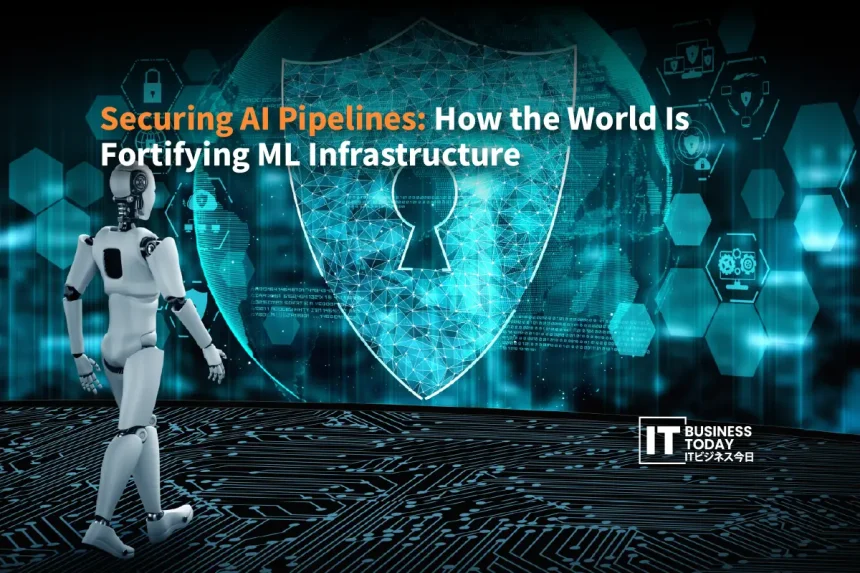Artificial intelligence has changed from a buzzword to the core of modern business. It drives competitive advantage in today’s market. Machine learning models are now key corporate assets. They create hyper-personalized customer experiences. They also optimize global supply chains. In the rush to deploy, a serious vulnerability has appeared. This weakness could endanger the whole company: it puts the AI pipeline’s security at risk. According to Gartner, 45% of organizations worldwide will experience an AI-driven cyberattack by 2026 if security isn’t prioritized. For business leaders, this is not just a tech issue anymore. It’s a key strategy they must prioritize. The world sees that an unsecured AI model is more than a tech problem. It’s a big business risk.
The AI pipeline is a complex and multifaceted organism. It begins with the lifeblood of any model: its training data. Data is gathered, cleaned, and processed through detailed workflows. Then, it’s fed to algorithms that seek patterns. The model is deployed. It’s monitored and refined over time.
Every stage of this lifecycle can be attacked:
- Data ingestion
- Processing
- Training
- Deployment
- Inference
Adversaries are no longer just breaching firewalls to steal data. They’re also learning to poison the source of your intelligence. The stakes are enormous. A 2023 IBM study found that the average cost of a data breach reached US$ 4.45 million globally, the highest ever recorded, with AI systems increasingly part of that risk surface.
Also Read: How Can Japan Use AI-Powered HR Tech to Improve Talent Retention and Growth?
The consequences of neglecting this frontier are severe. Picture a situation where a hidden, harmful change in your training data distorts your credit risk model. This could result in serious financial losses. Imagine a competitor adding subtle ‘noise’ to your visual inspection AI on the production line. This could lead the AI to miss important defects. Picture a ransomware attack that locks your data and holds your predictive models for ransom. These aren’t sci-fi scenes; they are real threats we face in today’s cyber world. Your AI systems’ integrity, confidentiality, and availability are tied to your company’s value and brand strength.
Understanding the Vulnerabilities
To fortify our defenses, we must first understand where we are exposed. The attack surface of an ML pipeline is vast and uniquely challenging.
A primary concern is data poisoning. An adversary with access to the training data can add corrupted or biased examples. The model learns from this flawed dataset. It incorporates the attacker’s desired failure mode right from the start. This is like teaching a child using a flawed textbook. The mistakes become part of their learning and are hard to unlearn later. An autonomous vehicle company could have serious issues if a hacker alters thousands of street sign images in its training library.
A complex threat is the evasion attack. This happens after deployment. An attacker creates special input data called an ‘adversarial example.’ This example misleads a model, causing it to make an incorrect classification. A famous example shows researchers placing small stickers on a stop sign. This made a computer vision model mistakenly see it as a speed limit sign. The effects on safety, security, and reliability are huge.
Model theft is a big economic threat. Attackers can use smart queries to reverse-engineer a proprietary model. This allows them to take valuable intellectual property and the large investment it brings, all without needing the source code. Model inversion attacks can rebuild sensitive training data using the model’s outputs. This risk may breach privacy laws like GDPR and CCPA, exposing personal information.
Strategies for Fortification

The global response to these threats has shifted. It now focuses on a structured approach called MLOps Security. This approach includes security at every step of the machine learning process. It helps create a culture of resilience.
The first line of defense is rigorous data provenance and governance. Organizations are setting up immutable audit trails. These trails track the origin, lineage, and changes of each data point used for training models. This helps spot anomalies and quickly isolate poisoned data. Think of it like blockchain for your AI training data. It’s a secure, verifiable record that ensures integrity.
During model development, adversarial training is now a common practice. This means creating adversarial examples and using them in training. This helps the model defend against future attacks. It makes the model’s decision boundaries stronger. This helps it resist deceptive inputs better. Companies are using formal verification methods from aerospace and chip design. These methods help mathematically prove that a model will work correctly within set limits.
Upon deployment, a zero-trust architecture is paramount. No part of the pipeline, whether internal or external, is trusted by default. Access controls are a must. Data must be encrypted, whether it’s stored or in transit. We must also keep an eye on how the model behaves all the time. Anomaly detection systems now monitor for more than just infrastructure breaches. They also look for changes in how well the model performs. These drifts can signal an ongoing attack. According to recent studies, 65% of organizations using Zero Trust report reduced incident response times.
The regulatory environment is also hardening. The EU’s AI Act and guidelines from the U.S. NIST are setting clear rules for safe, ethical, and responsible AI. For business leaders, compliance isn’t just about avoiding fines. It’s also a strong guide for creating trustworthy AI systems.
Cultivating a Culture of AI Security
Technology alone is insufficient. The human element is the key factor in securing AI infrastructure. This needs a big change in thinking. CISOs, data scientists, and business leaders must share a common language.
Bridging the chasm between the security team and the data science team is the first step. Traditionally, these functions have operated in silos. Security pros often don’t have deep ML skills. Data scientists may prioritize model performance over security protocols. Forward-thinking companies are breaking down barriers. They’re setting up AI security councils with members from different areas. They are also investing in ongoing education. They are hiring for new roles, such as AI Security Architect. This role needs professionals who know both cybersecurity and machine learning.
Furthermore, accountability must be clear. The business leader sponsoring an AI initiative must take on the associated risks. This means asking tough questions in board presentations. For example, has this model been stress tested against adversaries? What is our response plan if it is compromised? Who is accountable for its outputs? Incorporating these questions into governance makes sure AI security is taken as seriously as financial audits or corporate governance.
A Call to Action for Strategic Leadership

The era of naive AI deployment is over. According to Gartner, more than 40% of AI-related data breaches will be caused by the improper use of generative AI (GenAI) across borders. The next frontier for standing out in competition isn’t just about having the best algorithm. It’s about having a secure, strong, and trustworthy AI system. Boosting your ML pipelines is a wise choice for your business. It helps build trust for the future.
The journey begins with a comprehensive audit of your existing and planned AI systems. Work with experts to do a threat assessment. This helps you spot your biggest weaknesses. Invest in MLOps security platforms. They should offer visibility and control throughout the entire lifecycle. Foster a corporate culture where everyone knows that building AI responsibly is the only way to succeed.
The world is fortifying its digital future. Every business leader now faces a key question: it’s not if you will invest in securing your AI, but how quickly you can do it. Your intelligence, customer trust, and business resilience all depend on it.






